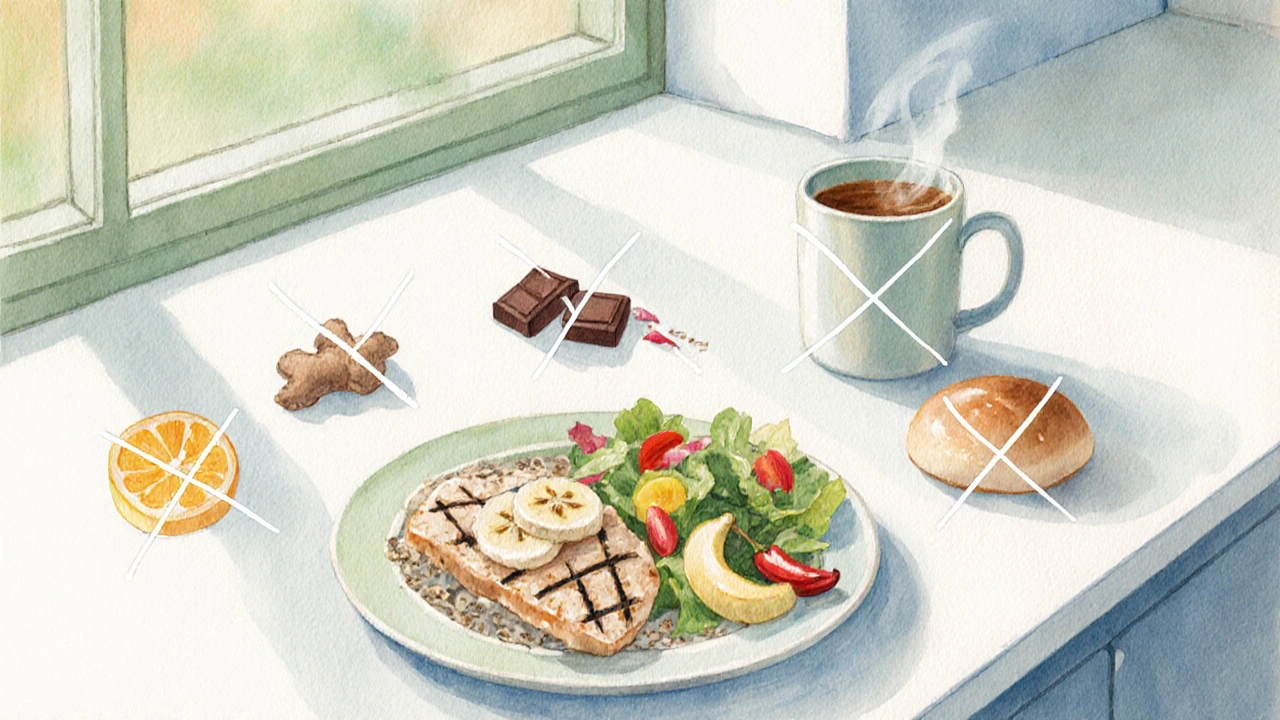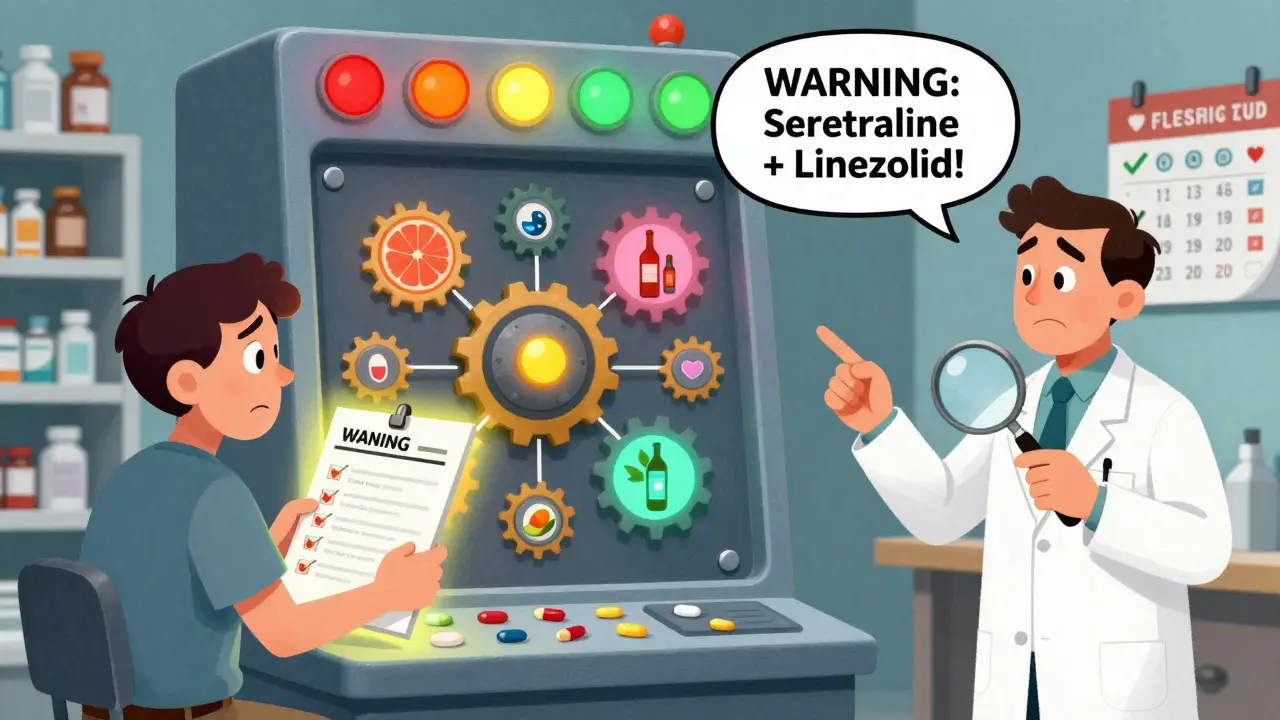GERD Symptom Tracker & Daily Checklist
Personal Trigger Identification
Click on foods below to mark them as potential triggers. Keep a record of how they affect you over time.
Common Triggers
- Citrus Fruits
- Tomato-Based Sauces
- Chocolate
- Caffeinated Beverages
- Spicy Foods
Healthy Alternatives
- Bananas
- Whole Grains
- Lean Proteins
- Herbal Teas
- Non-Citrus Vegetables
My Trigger Log
No triggers selected yet. Click items above to add to your log.
Daily GERD Management Checklist
Follow this checklist daily to maintain better symptom control.
Symptom Diary
Record your daily symptoms to identify patterns and track progress.
Recent Entries
No entries recorded yet. Add your first entry above.
Living with GERD is a chronic condition where stomach acid frequently flows back into the esophagus, causing heartburn and other uncomfortable symptoms can feel like a never‑ending battle. Between surprise flare‑ups at work, uncomfortable nights, and the constant need to watch what you eat, many people wonder if there’s any way to regain control. The good news? Small, consistent tweaks to diet, habits, and medication can dramatically lower the frequency and intensity of symptoms, letting you focus on the day instead of the burn.
Key Takeaways
- Identify personal trigger foods and keep a simple symptom diary.
- Adopt three core lifestyle habits: upright posture after meals, weight management, and smart bedtime routines.
- Choose the right medication strategy-antacids for quick relief, H2 blockers for moderate control, PPIs for long‑term suppression.
- Use the provided daily checklist to stay on track without feeling overwhelmed.
- Know red‑flag symptoms that require a doctor’s visit, such as difficulty swallowing or unexplained weight loss.
Understanding GERD
Gastroesophageal reflux disease, commonly shortened to GERD, occurs when the lower esophageal sphincter (LES) fails to close properly. In a healthy system, the LES acts like a valve, letting food pass into the stomach and then sealing shut. When this valve is weak or relaxes at the wrong time, acidic stomach contents spill back, irritating the lining of the esophagus.
Statistics from the World Gastroenterology Organisation show that roughly 20% of adults in Australia experience weekly heartburn, and about 10% meet the diagnostic criteria for GERD. The condition isn’t just uncomfortable-it can lead to esophagitis, Barrett’s esophagus, or even strictures if left unchecked.
Common Triggers and How to Spot Them
Everyone’s trigger list looks a little different, but research from the Australian Institute of Health identifies a handful of usual suspects:
- Citrus fruits (oranges, lemons, grapefruits)
- Tomato‑based sauces
- Chocolate
- Caffeinated beverages (coffee, tea, energy drinks)
- Spicy foods
- Fatty or fried foods
- Alcohol, especially wine and spirits
- Large meals and eating close to bedtime
To pinpoint your own culprits, keep a simple log for one week: note what you ate, the portion size, and any symptoms that appear within two hours. Over time patterns pop up, making it easier to eliminate the worst offenders.
Smart Food Choices: The GERD‑Friendly Plate
Instead of a restrictive “no‑eat‑this‑list,” think of building a plate that naturally keeps acid at bay. Below is a quick reference you can print and stick on the fridge.
| Favor | Limit |
|---|---|
| Oatmeal, whole grains, rice | White bread, pastry, deep‑fried items |
| Lean proteins - chicken, turkey, fish | Fatty cuts, processed meats |
| Non‑citrus fruits - bananas, melons, apples | Citrus fruits, pineapple |
| Vegetables (except tomato sauces) - broccoli, green beans, carrots | Tomato‑based sauces, chili peppers |
| Low‑fat dairy - yogurt, kefir | Full‑fat cheese, whole milk |
| Herbal teas (ginger, chamomile) | Coffee, caffeinated sodas |
Portion control matters too. Aim for meals that fill about half your plate, leave room for a small side, and finish eating within 20‑30 minutes. Smaller, more frequent meals reduce pressure on the LES.

Lifestyle Tweaks that Make a Real Difference
Beyond food, a handful of daily habits can keep acid where it belongs:
- Stay upright after eating. Walk or sit up straight for at least 30minutes. Even a light stroll helps gravity do its job.
- Elevate the head of your bed. Raising the mattress 6-8inches (using sturdy risers or a wedge pillow) lessens nighttime reflux.
- Maintain a healthy weight. Excess belly fat puts pressure on the stomach, encouraging reflux. A modest 5‑% weight loss can cut symptom frequency by up to 50% (Australian Health Survey, 2023).
- Wear loose clothing. Tight belts or waistbands compress the abdomen, triggering LES relaxation.
- Avoid smoking. Nicotine relaxes the LES and impairs saliva production, which normally buffers acid.
Integrating these habits gradually-say, focusing on one change per week-prevents overwhelm and builds lasting routines.
Medication Basics: What Works and When
When diet and lifestyle aren’t enough, medicines step in. Understanding the four main categories helps you choose the right tool for the job.
| Medication Type | How It Works | Typical Use | Key Considerations |
|---|---|---|---|
| Antacid | Neutralizes stomach acid instantly | Quick relief of occasional heartburn | May cause calcium overload; not for long‑term control |
| H2 Blocker | Reduces acid production by blocking histamine receptors | Mild to moderate symptoms, used 1-2times per day | Tolerance can develop after weeks |
| Proton Pump Inhibitor (PPI) | Blocks the final step of acid secretion | Severe or chronic GERD; usually taken before breakfast | Long‑term use linked to B12 deficiency & bone density loss; monitor with doctor |
| Prokinetic | Improves LES tone and speeds gastric emptying | Useful when motility issues contribute to reflux | Side effects include drowsiness; prescription only |
Most patients start with an antacid for fast relief, add an H2 blocker if symptoms persist, and move to a PPI for chronic control. Always discuss dosage and duration with a GP; a typical PPI course lasts 8-12 weeks before a “step‑down” plan is considered.
Tracking Progress and Knowing When to Seek Help
Even with a solid plan, occasional flare‑ups happen. Keeping a symptom diary-simple columns for “Time,” “Meal,” “Medication,” and “Score (0‑10)”-lets you see trends and identify gaps.
Red‑flag signs that warrant a doctor’s visit include:
- Difficulty swallowing or feeling of food stuck
- Unexplained weight loss (>5% in a month)
- Vomiting blood or material that looks like coffee grounds
- Chronic cough, hoarseness, or asthma‑like symptoms not responding to inhalers
If any of these appear, schedule an appointment promptly. Early detection of complications like Barrett’s esophagus improves outcomes.
Sample Daily GERD Management Checklist
- Morning: Take prescribed PPI with a full glass of water before breakfast.
- Breakfast: Choose oatmeal with sliced banana; avoid orange juice.
- Mid‑morning: Sip herbal ginger tea; stand up and stretch for 5 minutes.
- Lunch: Grilled chicken salad (no tomato), whole‑grain roll, and water.
- Afternoon: Record any heartburn episode; if mild, use chewable antacid.
- Evening: Finish dinner at least 3hours before bed; keep portion moderate.
- Pre‑bed: Elevate head of bed, wear loose pajamas, and do a 10‑minute breathing exercise.
- Before sleep: Check diary and note any night‑time symptoms.
Stick to this routine for two weeks, then adjust based on what your diary tells you. Small tweaks-like swapping a citrus snack for a handful of almonds-can shave minutes off your symptom score.
Frequently Asked Questions
Can I exercise if I have GERD?
Yes, but choose low‑impact activities like walking, swimming, or cycling. Avoid vigorous workouts right after meals; wait at least an hour. A study from Monash University showed that moderate cardio reduced reflux episodes in 60% of participants.
Is a hiatal hernia the same as GERD?
Hiatal hernia is a structural issue where part of the stomach pushes up through the diaphragm. It often co‑exists with GERD because the altered anatomy can weaken the LES, but not everyone with a hiatal hernia experiences reflux.
How long should I stay on a PPI?
Typical courses last 8-12 weeks. After symptoms improve, doctors usually taper to the lowest effective dose or switch to an H2 blocker for maintenance. Long‑term use should be monitored for bone health and vitamin B12 levels.
Are there natural remedies that actually work?
Aloe vera juice, deglycyrrhizinated licorice (DGL), and melatonin have modest evidence for reducing reflux symptoms. Use them under guidance, especially if you’re already on medication, to avoid interactions.
Can stress make GERD worse?
Stress can increase stomach acid production and lower the LES tone, amplifying symptoms. Mind‑body practices like meditation, deep breathing, or yoga have been shown to cut heartburn episodes by up to 30% in controlled trials.







April Rios
Everyone assumes GERD is just an occasional burn, yet the condition reveals a deeper misalignment between bodily intent and dietary habit; the esophagus becomes a battleground for misplaced ambition. In the grand theatre of digestion, the lower esophageal sphincter is the reluctant gatekeeper, often swayed by stress, volume, and the lure of acidic temptations. By recognizing this dynamic, one can reframe the daily checklist as a ritual of empowerment rather than restriction. Embrace the morning PPI as a ceremonial key, unlocking a day of comfort. Remember, the mind shapes the stomach as much as the stomach shapes the mind.
Natasha Beynon
It’s wonderful to see a structured approach to GERD; the checklist feels like a friendly roadmap. Keeping a symptom diary not only highlights triggers but also celebrates the small victories when a day passes without heartburn. Stick to the non‑citrus fruits and whole grains, and you’ll notice steady improvement. Adjustments should be gentle – think of them as stepping stones rather than hurdles. Stay consistent and give your body the respect it deserves.
Cinder Rothschild
The cultural narrative around food often glorifies spice and acidity as symbols of vitality. Yet when the esophagus protests, those symbols turn into shackles. Embracing a GERD‑friendly plate does not mean abandoning flavor; herbs, ginger, and mellow grains can whisper comfort. By honoring one’s own bodily signals, we rewrite the story of indulgence. Each meal becomes a dialogue rather than a dictation. The journey is lengthy but rewarding; patience cultivates resilience. Let the body guide the palate, and the mind will follow with ease.
Oscar Brown
When one examines the pathophysiology of gastro‑oesophageal reflux disease, it becomes apparent that the lower oesophageal sphincter functions as a finely tuned valve, whose integrity is compromised by a confluence of biomechanical and biochemical factors.
First, the attenuation of sphincteric tone, often precipitated by excessive intra‑abdominal pressure, permits retrograde migration of gastric contents.
Second, the intrinsic irritative potential of hydrochloric acid exacerbates mucosal inflammation, thereby perpetuating a vicious cycle.
Third, dietary constituents rich in caffeine, nicotine, and fatty acids serve as potent antagonists to sphincteric competence.
Consequently, a multifaceted therapeutic regimen is warranted, encompassing both pharmacologic intervention and lifestyle modification.
Proton pump inhibitors, administered under strict medical supervision, effectuate a profound reduction in acid secretion, thereby affording mucosal healing.
Adjunctive use of H2 receptor antagonists can mitigate nocturnal breakthrough symptoms.
Furthermore, elevation of the head of the bed by six to eight inches harnesses gravitational forces to impede reflux during supine repose.
Engagement in modest physical activity post‑prandially enhances gastric emptying and diminishes reservoir volume.
Weight optimization, achieved through caloric moderation and regular exercise, attenuates diaphragmatic pressure.
Temporal separation of the final meal from bedtime by a minimum of three hours is a cornerstone of nocturnal symptom control.
Incorporation of alkaline‑rich, low‑fat foods, such as oatmeal and non‑citrus fruits, provides a buffering effect against acid exposure.
Meticulous documentation via a symptom diary empowers the patient to identify idiosyncratic triggers and to calibrate therapeutic adjustments.
Regular follow‑up with a gastroenterologist ensures surveillance for complications, including Barrett’s esophagus.
In sum, the amalgamation of evidence‑based pharmacotherapy, strategic dietary choices, and disciplined lifestyle habits constitutes the optimal paradigm for GERD management.
Tommy Mains
Here’s a quick tip: write down what you ate and how you felt right after. Seeing patterns on paper helps you avoid the worst foods. Keep the language simple – no need for fancy terms. If a snack causes a flare, note it and try a substitute next time. Small changes add up to big comfort.
Alex Feseto
One must perceive the management of reflux not as a mere regimen but as an exercise in aristocratic self‑discipline. The elevation of the nocturnal repose, the judicious selection of alimentary fare, and the calibrated administration of pharmacologic agents coalesce into a symphony of salutary propriety. To neglect such decorum would be to partake in culinary anarchy.
vedant menghare
Across cultures, the relationship with food is both sacred and pragmatic; when GERD intrudes, we must honor that duality. Imagine the soothing hum of ginger tea as a bridge between tradition and treatment, a fragrant compromise that eases the esophageal revolt. The vibrant hues of non‑citrus fruits paint a palate of comfort, while whole grains lay a sturdy foundation. Let us celebrate culinary diversity while respecting the body's boundaries, weaving a tapestry where flavor and health coexist harmoniously.
Kevin Cahuana
Hey, I get how tough the reflux rollercoaster can be. Try taking a short walk after meals – even five minutes can keep things moving downward. If you feel a flare, a quick sip of aloe vera juice might calm the burn. Remember, it’s okay to tweak the plan, just keep an eye on what works for you.
Danielle Ryan
They’re tracking every bite, and the government’s satellite diet program is watching your heartburn!!!
Robyn Chowdhury
Another checklist, another day of endless monitoring…🤦♀️
Deb Kovach
Great summary! 👍 Keep using the diary – it’s the best way to spot patterns. If you need a quick reference, the table of foods to favor vs. limit is perfect. 🌟
Sarah Pearce
i dont kno wht dis is!!!??!!??!!
Ajay Kumar
Hey buddy, glad you’re taking steps to manage GERD. A gentle reminder: stay hydrated and avoid tight clothes – they can add pressure. If something feels off, just tweak the schedule a bit. You’ve got this!
Richa Ajrekar
The guidelines you posted are decent, but the omission of regional dietary practices is a glaring oversight. A truly comprehensive plan must respect the culinary heritage of all populations, not just Western norms. Otherwise, it risks alienating a large segment of sufferers.